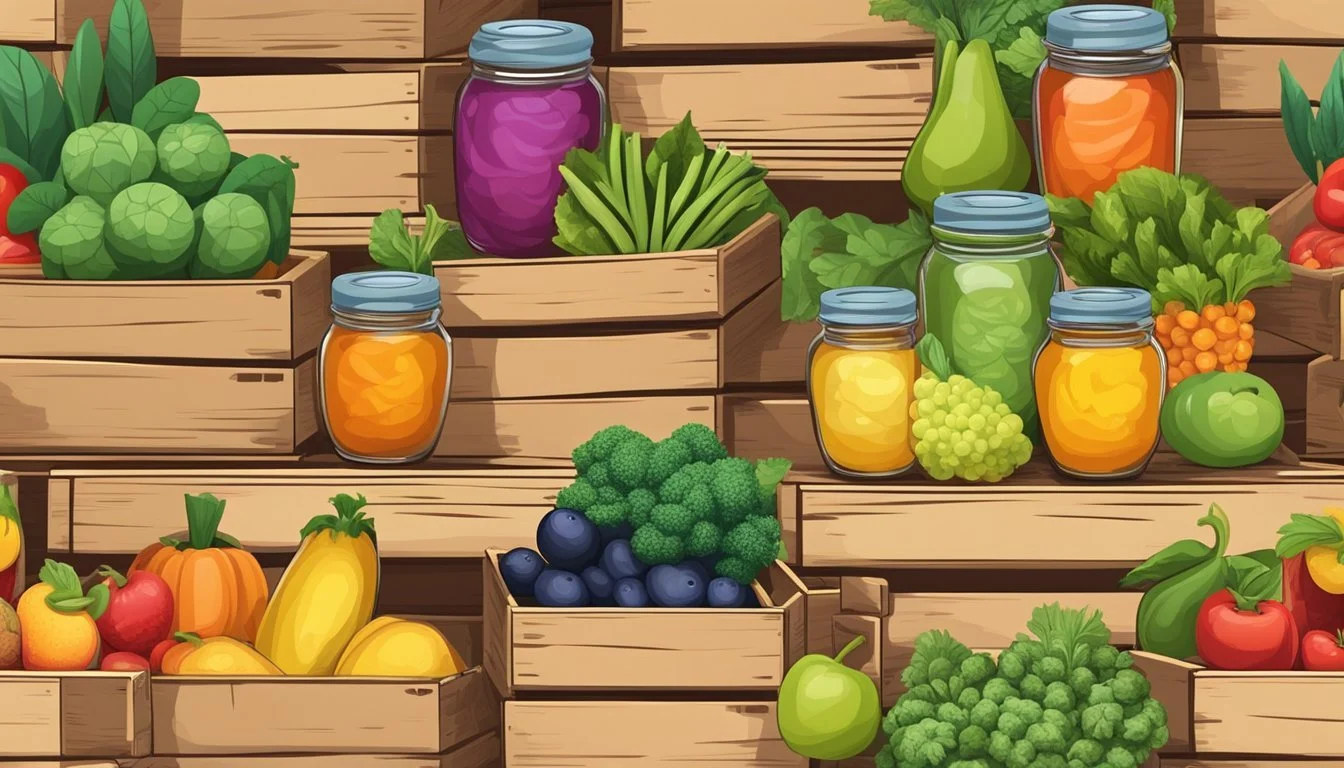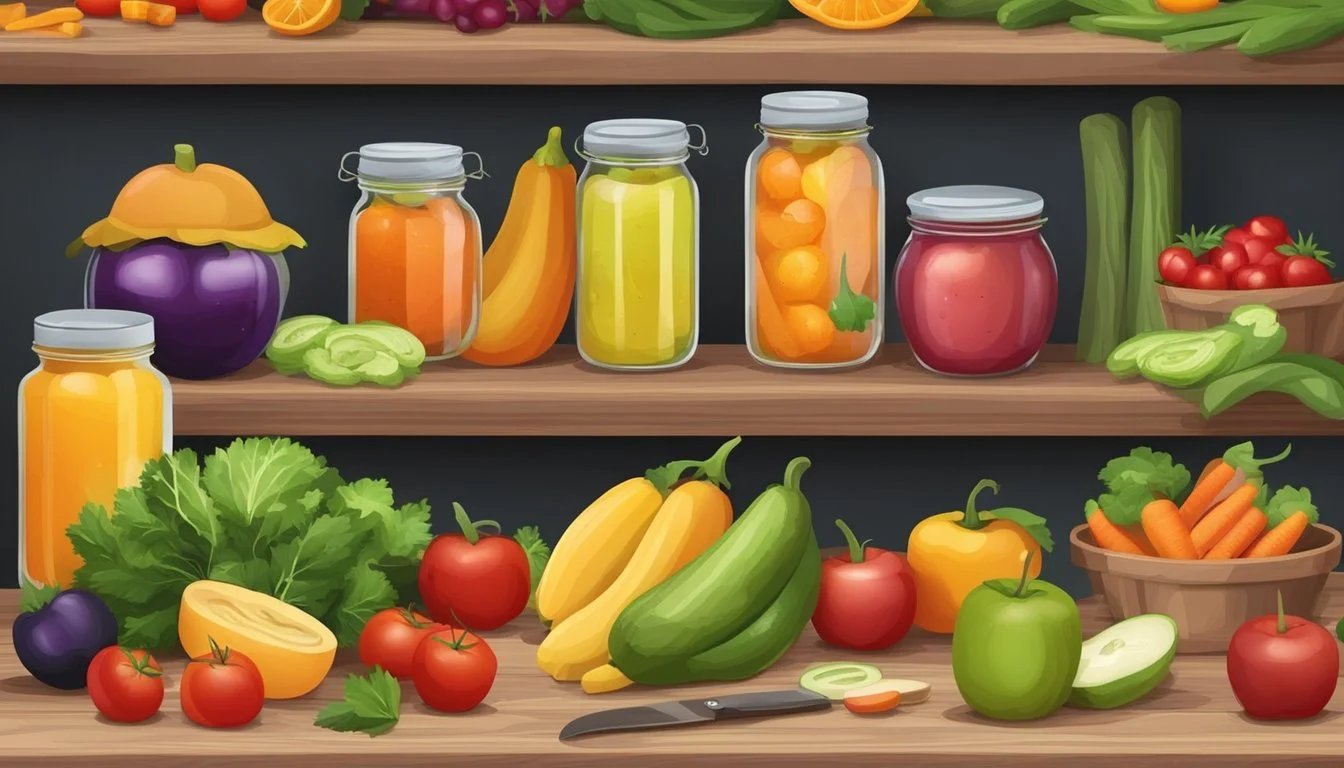The Best Farmers' Market Finds for Homemade Baby Food
Top Picks for Nutritious Ingredients
As parents increasingly prioritize the nutritional content and quality of their baby's meals, homemade baby food has become a popular choice for those looking to control ingredient quality and avoid preservatives and additives commonly found in pre-packaged products. The local farmers' market serves as a treasure trove for fresh, nutrient-rich produce perfect for creating wholesome, healthy baby food. Local markets not only provide a variety of seasonal ingredients but also offer the opportunity to support community farmers and sustainable agriculture.
Making baby food from scratch allows caregivers to introduce their little ones to a wide range of flavors and textures while ensuring that the meals are tailored to their nutritional needs. Fresh produce from farmers' markets is often picked at its peak freshness, ensuring that the fruits and vegetables retain more nutrients and flavor than their store-bought counterparts. This not only benefits the baby's health but can also help develop their palate and appreciation for real food from a young age.
As one ventures through the vibrant aisles of farmers' markets, they will find an abundance of options for baby food creations. From sweet, fibrous apples that promote digestive health to vibrant leafy greens rich in iron and essential minerals, the seasonal picks can be transformed into soft, pureed meals that suit the developmental stages of young children. Each choice at the farmers' market enables caretakers to make informed decisions about what goes into their homemade baby food, fostering a healthy start for their children.
Selecting Quality Produce
When venturing to the farmer's market for baby food ingredients, focusing on the freshness and nutritional content of produce is paramount. It's essential to make informed choices between organic and non-organic products, as well as to consider the benefits of seasonal availability for fruits and vegetables.
Seasonal Fruit Varieties
At the farmer's market, seasonal fruits like strawberries in spring and apples in the fall are often fresher and tastier. Prioritize:
Berries: Strawberries, blueberries, raspberries, and cherries usually ripen in late spring to summer.
Tree fruits: Apples, peaches, and pears are common in late summer to fall.
Tropical flavors: Bananas and avocados, although not local to all areas, should appear vibrant and yield slightly to pressure.
Fresh Vegetables for Purees
The following vegetables are excellent for purees:
Root vegetables: Carrots and sweet potatoes, noted for their high vitamin content.
Greens: Spinach, kale, and broccoli deliver iron and essential nutrients.
Others: Peas, bell peppers, and zucchini provide a variety of textures and flavors.
Vegetables should be firm, bright in color, and free from blemishes.
Organic vs Non-Organic
Choosing between organic and non-organic products depends on availability and budget:
Organic: Free from synthetic pesticides and fertilisers but typically more costly.
Non-Organic: More affordable, but consider the Environmental Working Group's list of the "Dirty Dozen" as a reference for what items to buy organic.
Herbs and Flavor Enhancers
Incorporate fresh herbs and mild spices to enhance baby food flavors without added salt:
Herbs: Basil, mint, parsley, cilantro, and dill can be mixed into purees for an introduction to new flavors.
Aromatics: Garlic and onion should be used sparingly for babies' delicate palates.
Spices: A pinch of cinnamon can add warmth to fruit purees.
Choosing quality produce at the farmer's market lays the foundation for healthy, homemade baby food. Selecting fresh, seasonal items provides maximum flavor and nutrition for developing palates.
Baby Food Preparation Techniques
Creating homemade baby food allows for control over ingredients, ensuring a nutritious meal. It involves multiple methods of puréeing, cooking, and storage. By mastering these techniques, caregivers can offer diverse, healthy options that cater to a growing infant's palate and nutritional needs.
Pureeing and Blending
To achieve a smooth and creamy consistency ideal for infants, caregivers should use a blender or food processor. Starting with soft, cooked ingredients, they pulse the food until it reaches the desired texture. For younger babies, a thinner purée is best, while older infants may enjoy more texture.
Cooking Methods for Nutrient Retention
Steaming is a preferred method for preserving vitamins and minerals in homemade baby food. This can be done traditionally on the stovetop or using an Instant Pot for convenience. Other methods like boiling or roasting are also viable but may reduce the nutrient content. Adding a dash of olive oil can help with nutrient absorption without compromising health.
Storage and Shelf Life
Caregivers should store baby food in clean, airtight containers. For immediate use, refrigeration can keep the meal fresh for up to 48 hours. For long-term storage, caregivers often use the freezer, employing ice cube trays for easy portioning. Thawed meals should be consumed within 24 hours for safety and quality.
Combining Flavors and Textures
Introducing infants to a variety of flavors and textures is important for their development. Caregivers can mix different fruits and vegetables, adding mild herbs or spices for flavor complexity. Ingredients like cheese may be introduced in small amounts for additional texture and taste in older infant's meals.
Recipe Ideas and Meal Planning
Crafting homemade baby food from farmers' market finds ensures fresh, nutrient-rich meals for little ones. This section provides a variety of recipes that incorporate seasonal produce and whole grains, perfect for different times of the day.
Breakfast Options
A morning meal can be both wholesome and simple. Pureed fruits like apples or pears, mixed with a bit of oatmeal or cereal, create a gentle and nutritious start for the day. These options are easy to digest and can be adjusted for texture as babies grow.
Apple Cinnamon Oatmeal: Cook and puree apples with a pinch of cinnamon, then swirl into oatmeal.
Mixed Berry Delight: Blend seasonal berries into a smooth puree and serve with a side of cereal for dipping.
Lunch Selections
Lunch is an ideal time to introduce a variety of vegetables and grains. A chicken and vegetable puree provides protein and vitamins, while softly cooked grains offer energy for play and growth.
Chicken and Sweet Potato Puree: Combine cooked chicken breast and sweet potato for a hearty lunchtime meal.
Green Veggie Medley: Puree a mix of green beans, peas, and spinach for a nutrient-packed lunch.
Dinner Inspirations
Dinner can include an array of vegetables, richer proteins like beef, and a complex carbohydrate as a side dish. These foods help babies wind down the day with a satisfying and sleep-promoting meal.
Beef and Carrot Puree: Ground beef and carrots make for a high-iron dinner option.
Squash and Brown Rice: Blend roasted squash with cooked brown rice for a filling evening meal.
Snacks and Finger Foods
Healthy snacks and finger foods can stimulate a baby's fine motor skills and provide energy between meals. Soft, bite-sized pieces of fruit or vegetables and small cubes of cheese are great for on-the-go nourishment.
Steamed Carrot Sticks: Softly cooked and cooled for tiny hands to hold and munch.
Cheese Cubes: Mild cheeses cut into small, manageable pieces for practicing pincer grips.
Understanding Nutrition and Dietary Needs
When creating homemade baby food, it is critical to consider the child's growing body and developmental needs. Nutritionally balanced meals support overall health and proper growth.
Balancing Macronutrients
Homemade baby food should provide an appropriate balance of proteins, carbohydrates, and fats. Proteins are crucial for growth and repair of tissues, while carbohydrates provide energy. Fats are important for brain development and the absorption of fat-soluble vitamins. For example, pureed meats and legumes offer protein, mashed sweet potatoes or bananas are rich in carbohydrates, and avocado provides healthy fats.
Vitamins and Minerals Essentials
A range of vitamins and minerals are essential in a baby's diet. Vitamin A, important for eye health, can be found in carrots and sweet potatoes. Vitamin C, which supports the immune system, is plentiful in fruits like oranges and strawberries. Iron-rich foods, such as spinach, support red blood cell production, and calcium, necessary for bone development, can be sourced from dairy products and greens.
Introducing Solids and Allergy Awareness
Introducing solids begins around six months of age, and it's crucial to be mindful of common allergens like eggs, dairy, and nuts. Pediatricians recommend introducing new foods one at a time to monitor for allergic reactions. Options such as single-ingredient purees of fruits and vegetables are generally safe initial foods.
Hydration and Fluid Intake
Infants primarily need breast milk or formula to meet their hydration needs. Water can be introduced around the six-month mark, but in limited quantities. Juices, particularly those with added sugars, are less recommended due to their lack of nutritional value and potential contribution to tooth decay.
Health and Safety Considerations
When preparing homemade baby food from farmers' market finds, safety is paramount. Ensuring that both the ingredients and the utensils used are clean, safe, and have not been subject to recalls or safety alerts is crucial in maintaining the health of the baby.
Sanitation and Cleanliness
One must sanitize all fresh produce before pureeing it into baby food. This involves thorough washing to remove any bacteria or pesticides. It's advised to use a produce brush and running water to clean fruits and vegetables, and to peel when necessary, especially for non-organic items to reduce exposure to residues.
Choosing Eco-Friendly and Safe Utensils
When selecting utensils like spoons and bowls for feeding, opt for products that are free from BPA and other harmful chemicals. Utilize utensils made from non-toxic, eco-friendly materials such as silicone, bamboo, or stainless steel to ensure the safety of the baby's food.
Navigating Food Recalls and Safety Alerts
Stay informed about recalls and safety alerts regarding food products. Monitor reliable sources such as the U.S. Food and Drug Administration (FDA) or the U.S. Department of Agriculture (USDA) for updates. In case of a recall, remove any affected foods from the baby's diet immediately to maintain a safe feeding environment.
Supporting Local Agriculture
When consumers purchase from farmers' markets, they bolster community economies and obtain fresh produce straight from the source. This section zeroes in on how such support is beneficial, cultivates vendor relationships, and sometimes even inspires personal gardening endeavors.
Benefits of Shopping at Farmers' Markets
Farmers' markets are vital for local economies as they support small and mid-sized farmers. Here, consumers find an array of fresh veggies and organic produce that often surpasses what's available in supermarkets both in variety and nutritional quality. Consumer support at these markets directly contributes to the viability of local farms.
Support Local Economy: Money spent here stays within the community, fostering local employment and businesses.
Freshness and Variety: Markets offer seasonal produce that is frequently picked at peak ripeness, promising optimal flavor and nutrition.
Forming Relationships with Vendors
Building a relationship with local farmers and vendors generates trust and a valuable exchange of knowledge. Shoppers can learn about the produce they're buying, the best selections for certain dishes, and even how the food was grown.
Trust: Knowing the person who grows your food creates confidence in the safety and quality of the items purchased.
Knowledge: Engaging with vendors can educate buyers on farming practices, which is often crucial for those concerned with organic and sustainable methods.
Growing Your Own Food
Interacting with vendors at farmers' markets can also provide inspiration and advice for starting a personal garden. Many vendors are happy to share tips on starting a successful garden, which can lead to even more fresh, organic options at home.
Start Small: Choose easy-to-grow items like herbs or tomatoes for initial success.
Organic Practices: Apply the organic knowledge gained from market vendors to grow produce without the use of synthetic pesticides or fertilizers.
Tips and Tricks for Busy Parents
For busy parents aiming to prepare homemade baby food, efficient strategies such as batch cooking, meal prepping, and the use of kitchen gadgets are indispensable. These methods not only save time but also offer a way to involve their children in meal choices, fostering early food education.
Batch Cooking and Meal Prepping
Batch cooking is the practice of preparing large quantities of food at once, then storing it for later use—a time-saving godsend for parents. Busy parents can dedicate a few hours over the weekend to cook and puree a variety of farmer's market finds like sweet potatoes, peas, or carrots. These can then be frozen in ice cube trays, resulting in readily available single-serving portions that make meal prep a breeze throughout the week.
Tools to Consider:
Blender: for smooth purees.
Food Processor: for slightly chunkier textures.
Utilizing Kitchen Gadgets
Time-saving kitchen gadgets are a boon for rapidly turning fresh market produce into nutritious baby food. An Instant Pot can steam vegetables in minutes, while a blender or food processor can puree them quickly. Gadgets like these transform meal prep from a chore into a swift, simple process, giving parents more precious time with their children.
Gadget Benefits:
Speed: Cooks and purees food quickly.
Efficiency: Makes meal prep manageable.
Involving Your Child in Meal Choices
Education about food begins with exposure to choices and preferences. As children grow and start expressing their likes and dislikes, parents can involve them in selecting fruits and vegetables at the farmers' market. This interaction not only educates but also makes children more inclined to eat the food they chose. Additionally, parents can use these preferences to guide their batch cooking and meal prep for the week, ensuring the food is both healthy and appealing to their child.
Key Points:
Choices: Offer a variety of options and respect the child's preferences.
Preferences: Use them to tailor the week's menu.
Dietary Variations and Adaptations
When creating homemade baby food, it's essential to consider various dietary needs and preferences. Farmers' markets provide an array of options that cater to vegetarian, vegan, gluten-free, and dairy-free diets, making it easier to adapt family meals for babies while maintaining an inclusive table.
Vegetarian and Vegan Options
Farmers' markets are a treasure trove for those seeking plant-based ingredients suitable for vegetarian and vegan baby food. One can find:
A diversity of leafy greens like spinach and kale, rich in iron and calcium.
A colorful variety of fruits and vegetables to stimulate babies' palates and provide vital nutrients.
Engaging with local growers also opens the door to learning about the produce's origin, ensuring that the baby's food is not only nutritious but also ethical and sustainable.
Gluten-Free and Dairy-Free Alternatives
For families dealing with allergies, gluten or dairy sensitivities, farmers' markets offer a range of suitable alternatives. Look out for:
Gluten-free grains like quinoa or buckwheat that can be ground into flour for baby-friendly cereals.
Fresh, dairy-free products such as coconut milk or almond milk that can be used in purees and baby cereals.
These options help parents craft safe, healthy meals that mirror the family's dietary restrictions.
Adapting Family Meals for Babies
Incorporating fresh market finds into family meals that are suitable for babies allows for easier meal planning and fewer separate preparations. Considerations include:
Soft-cooked vegetables and fruits from the market can be easily mashed or pureed for baby consumption.
Single-ingredient purees can be a gentle introduction for babies starting on solids, later combined for more complex flavors.
By choosing market produce, caregivers can include their baby in family meals from the outset, fostering inclusive eating habits and simplifying the transition to solid foods.
Elevating Baby Food with Farm-Fresh Ingredients
Crafting homemade baby food using farm-fresh ingredients allows parents to introduce their little ones to a world of vibrant flavors and diverse nutrients. This journey enriches the infant diet and makes mealtimes an explorative experience.
Farm to Table Baby Recipes
Parents interested in homemade baby food can translate the bounty of the farmers’ market into baby food recipes with minimal effort. For example, a simple puree of roasted market carrots and a dash of cinnamon can excite a baby's palate. Using fresh, organic produce from the market ensures that babies are getting wholesome nutrition without added preservatives found in some store-bought options.
Seasonal Feeding Schedule
Adapting a seasonal feeding schedule means that babies are exposed to a variety of tastes throughout the year, encouraging diversification in their diets. A table summarizing suitable ingredients by season could look like this:
Season Ingredients Spring Peas, carrots, apples Summer Berries, zucchini, peach Autumn Squash, pumpkin, pear Winter Sweet potato, kale, beet
Introducing seasonal foods helps to cultivate a palate that is in sync with the natural growing cycles, providing optimal nutrients when they are at their peak.
Infusing Culinary Trends into Baby Food
Parents can also draw inspiration from modern cuisine and culinary trends to enhance their homemade baby food. Incorporating elements of innovative cooking, such as pureeing avocado with banana for a creamy and nutritious treat, reflects contemporary trends towards healthy fats and novel flavor combinations.
Visiting the Farmers' Market with Your Baby
Attending a farmers’ market can be both an educational experience and a family outing, where parents and babies enjoy the sights, sounds, and smells of local commerce. It is an opportunity to teach children about the source of their food and the importance of supporting local farmers and artisans. The market transforms grocery shopping into a sensory-rich experience that can be enjoyed as a family ritual.
Conclusion and Additional Resources
Farmers' markets provide an abundance of fresh, local produce ideal for creating nutritious homemade baby food. The advantages for a family's health and the healthy lifestyle promoted through this practice are notable. Parents can ensure their baby's food is free of added sugars and salts, fostering better eating habits from the start.
For those seeking educational resources, numerous guides and studies offer insights. Community GroundWorks provides practical advice on making baby food, while Healthy Babies Bright Futures holds studies on heavy metal levels in various foods.
Community involvement is pivotal. Engaging with local farmers and food initiatives supports regional agriculture and promotes a sustainable cycle of consumption.
Useful Guides and Organizations:
Community GroundWorks: Offers tips and benefits for preparing local baby food.
Healthy Babies Bright Futures: Conducts research on food safety for babies.
Tips for Starting:
Selection: Choose a variety of fruits and vegetables at peak season for best flavor and nutrition.
Preparation: Follow safe cooking methods to preserve nutrients and ensure digestibility.
For precise, step-by-step instructions, WebMD's guide on homemade baby food preparation is a valuable read. It delineates methods like washing, peeling, and cooking that are simple and effective.
Support Local:
Farmers' Markets: A venue to ask questions and get fresh produce.
Local Food Movements: Join or support these to advocate for local, quality food choices.
Homemade baby food not only fosters a healthy lifestyle but also encourages community involvement. Parents become proactive in their child's nutrition while supporting local economies. The resources provided here serve as a framework for embarking on this fulfilling journey.












